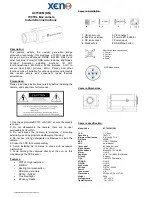
BASIC OPERATION
Alarm operation
If alarm input sources such as a door bell, an interphone, etc.,
are connected to the ALARM IN terminals on the power unit,
when an external alarm trigger is received at the alarm input
terminals, the camera will move to its corresponding preset
position.
Also, the alarm list can be displayed on the menu screen of the
system controller. Refer to page 4, for more information on
connections.
1
Alarm operation setting
Select “ALARM OUT” on the system controller call-up
commands, then set it to “ON”.
2
Alarm duration setting
Set the duration using DIP switch No. 3 of the RS-485 BAUD
RATE switch.
For example, if the duration is set to ON (5 seconds), after an
alarm is triggered another alarm will not be received for 5
seconds.
The default settings are ON (5 sec.).
(Displaying the alarm list)
This is done using DIP switch No. 4 of the RS-485 BAUD
RATE switch.
The default setting is ON (alarm list displayed), if set to OFF
the alarm list will not be displayed.
Power supply synchronization setting
(L-L)
Make this adjustment if the image on monitor rolls vertically.
1
Select the sync signal
Select the internal sync (INT) or the line-lock using DIP switch
No. 2 of switch SW1 and DIP switch No. 3 of switch SW2 on
the external sync control panel.
•
When the internal sync is set to OFF, DIP No. 3 of SW2
must also be set to ON.
•
When the line-lock is set to ON, DIP No. 3 of SW2 must
also be set to OFF.
2
Vertical sync adjustment
Select “L-L PHASE” on the system controller call-up
commands, then adjust the vertical sync phase.
L53Y4/XE (VCC-9250P GB) 2000. 11. 28
9

































